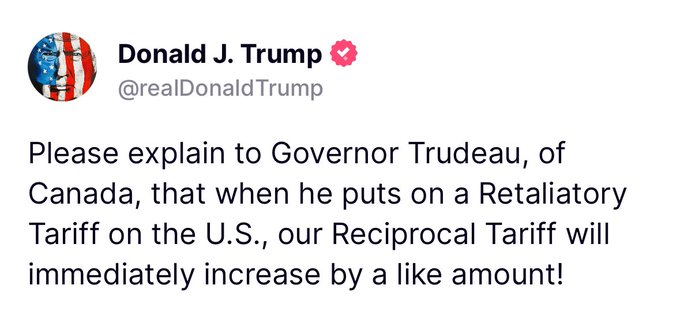Always a Trump supporter.^^^^^
Biggest ASSHOLE ever known to man.
You are using an out of date browser. It may not display this or other websites correctly.
You should upgrade or use an alternative browser.
You should upgrade or use an alternative browser.
Trudeau announces 25% retaliatory tariffs on US goods
- Thread starter Diogenes
- Start date
The result is higher prices for American consumers. I guess that is tough for Dio to understand.

Damn, do you type dumb shit. You apparently like economic warfare.America will crush Canada unless they bend the knee. We have states with higher GDP than their whole country.
100,000 Americans a year are dying from overdose . Most of which are from fentanyl. Trump is trying to prevent it. He needs our neighbors help. They have not been helping. Trump is getting their attention.The result is higher prices for American consumers. I guess that is tough for Dio to understand.
We are the largest consumer economy in the world. Canada's economy needs to sell to us to stay afloat.America will crush Canada unless they bend the knee. We have states with higher GDP than their whole country.
We are the largest consumer economy in the world. Canada's economy needs to sell to us to stay afloat.
We shall see, won't we?
Canada’s nominal GDP in 2023 was approximately $2.14 trillion USD, according to the International Monetary Fund (IMF) and other sources like the World Bank. Projections for 2024 suggest it could be around $2.2 trillion USD, though exact figures for 2025 are not yet finalized. For U.S. states, the Bureau of Economic Analysis (BEA) provides GDP data, with 2024 estimates being the most current as of late 2024.
Based on this, the U.S. states with GDPs exceeding Canada’s $2.14 trillion (2023) or $2.2 trillion (2024 estimate) are:
@Grok
Based on this, the U.S. states with GDPs exceeding Canada’s $2.14 trillion (2023) or $2.2 trillion (2024 estimate) are:
- California: In 2024, California’s GDP is estimated at $4.08 trillion USD. This far surpasses Canada’s GDP, making it the largest state economy in the U.S. and comparable to the world’s fifth-largest national economy (e.g., India’s $3.57 trillion in recent years).
- Texas: Texas had a GDP of approximately $2.695 trillion USD in 2024. This exceeds Canada’s GDP by a significant margin, aligning Texas with economies like Italy or Canada itself in earlier years ($1.73 trillion in 2018).
- New York: New York’s GDP in 2024 is estimated at $2.284 trillion USD. This is slightly above Canada’s 2023 figure and likely its 2024 estimate, making New York another state with an economy larger than Canada’s.
@Grok

Canada’s economy relies heavily on the United States, primarily due to its significant trade dependence, geographic proximity, and integrated supply chains.
The most striking indicator is trade: in 2024, 75.9% of Canada’s merchandise exports—totaling $412.7 billion USD—went to the U.S., according to data from the U.S. Customs Service and corroborated by Statistics Canada trends.
This makes the U.S. by far Canada’s largest export market.
Comparatively, Canada’s next biggest export destinations, like China (4.1%) and Japan (2.3%), account for far smaller shares.
Imports tell a similar story: in 2024, Canada imported $349.4 billion USD in goods from the U.S., representing roughly 60-65% of its total goods imports, depending on the exact figures for other partners like China (12%) and Mexico (5%).
Beyond goods, services and investment also tie Canada to the U.S. In 2023, the U.S. accounted for 57% of Canada’s service exports (e.g., travel, financial services), and American foreign direct investment in Canada was valued at over $455 billion USD, dwarfing investments from other countries.
Economically, Canada’s GDP—around $2.2 trillion USD in 2024—pales next to the U.S.’s $28 trillion-plus, and its export-driven growth (exports are ~30% of GDP) hinges on U.S. demand. If U.S. imports dropped significantly, models suggest Canada’s GDP could contract by 2-5% in a year, far outpacing impacts on the U.S. from a similar disruption.
In short, Canada’s economy relies heavily on the U.S. for trade, investment, and market access.
@Grok







